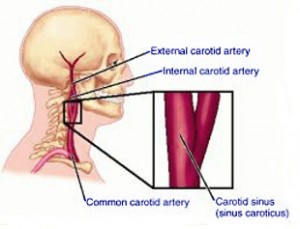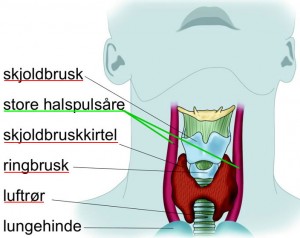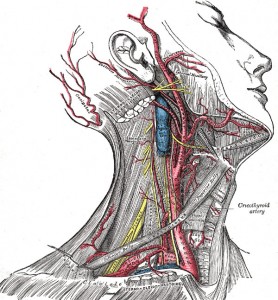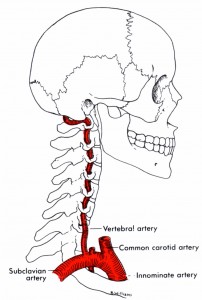TECHNIQUES AND SAFETY WHEN USING BLOOD CHOKES
Preface and Disclaimer
Blood Chokes is a martial arts technique intended to pacify the recipient in a safe and psychologically very effective way, but which may, under the wrong conditions, have fatal (literally) consequences.
The use of fainting with Blood Chokes is surrounded by a great deal of misunderstanding and ignorance. Therefore, I have tried to collect and interpret available information, couching it in plain language.
The page is relevant for martial arts practitioners, police, bouncers, and those employed in the security industry, and as part of any debate about deliberate use of fainting.
Naturally, all claims and opinions reflect my personal views, and since no person can claim to know ultimate truth, I have included links to other sources to the extent possible.
The information and conclusions are provided in collaboration with professionals, and will be updated regularly. I welcome suggestions and additions, as long as they are well documented at bloodchokes (at) gmail.com
How dangerous is it?
Based on my experience and research, I find three factors that can make the use of Blood Chokes dangerous and reckless:
- Wrong execution.
• Holding the grip for too long.
• The recipient is suffering from a serious heart/circulation related illness.
In order to judge, whether the use of Blood Chokes is reckless, I will here review the most important factors, along with the factors that are normally misunderstood. Therefore, part of the focus falls on the diseases that, combined with Blood, Choke, can have fatal outcomes.
According to who you ask and in which context, you can get many different answers. Normally, doctors consider it their duty to advise against anything dangerous. The question is much more interesting, if you ask to have Blood Chokes evaluated as opposed to something like a blow to the head with a boxing glove.
In martial arts, such as Brazilian jiu-jitsu, Blood Chokes are techniques that are considered harmless, and I have not managed to find a single accident in the history.
The closest I could find was a child in the US, who passed away after his friend had blocked his carotid arteries for several minutes, while they were playing UFC fighting.
In the US, Blood Chokes are considered safe when used by an officer with proper training.
Blood Choke vs. Air Choke
In martial arts, we divide chokes into 2 categories, Air Chokes and Blood Chokes:
Air Chokes: The opponent (=recipient) is prevented from breathing and faints after ½ to 5 minutes due to a lack of oxygen in the blood traveling to the brain. This is done by e.g. holding an arm/hand in front of the mouth and nose or by putting pressure on the trachea. Often the cartilage around the trachea and larynx is fragile, and strong pressure/blows should be avoided at all times, as permanent damage to the cartilage can occur. Air Chokes, then, do not prevent blood flow to the brain, per se, but instead oxygenation of the blood from the lungs.
Blood Chokes: Turn off the brain in a matter of 5-14 seconds by blocking or restricting the flow of blood, and thus the oxygen supply to the brain through the carotid arteries. Even the most experienced martial arts practitioners tap out (=surrender by patting the opponent or the floor twice) at the last moment before fainting. The effect of Blood Chokes increases and decreases very quickly, because the supply of fresh oxygen to the brain is cut off almost immediately, and as soon as the Choke grip is removed from the carotid arteries, the brain is once again supplied with freshly oxygenated blood.
If the recipient does not tap out and the grip is still maintained, the opponent will faint. For safety’s sake, a fainted or woozy opponent should always be laid on his back carefully with his head slightly bent back in order to ensure clear airways, so the blood again can be pumped to the brain easily. After this, the recipient’s pulse and breathing is checked. The breathing can, in extreme cases sound like snoring and lag a few seconds, but the pulse/heartbeat must never disappear, just as the heart rhythm must never fibrillate.
Fainting is
Fainting is to lose consciousness completely for a brief period from seconds to minutes.
When you black out, feel mentally dazed, and/or see small twinkling dots, you are very close to passing out.
Several circumstances can lead to fainting. For some people it may occur spontaneously as a reaction to very strong mental and/or physical experiences, such as traffic accidents.
Aside from Blood Chokes, fainting is also seen in various children’s games, which are typically a combination of rising quickly, where the person changes quickly from holding his head very low to having his head up very high, or when creating pressure by pushing the recipient hard in the chest or when blowing hard into your own thumb.
The most well-known and natural occurrence of fainting is when you rise very quickly from a state of being relaxed with decreased blood pressure.
Blood pressure is regulated automatically as needed, and when the head is placed level with or below the heart, the heart only needs to pump with very weak beats. If you rise to a vertical position too quickly, the heart does not have time to increase the blood pressure quickly enough for the brain, as more blood goes to the legs, changing the pressure distribution, so the freshly oxygenated blood from the heart temporarily doesn’t make it all the way up to the brain.
When the blood flow to the brain is prevented, it quickly runs out of oxygen, and all muscles in the body are gradually relaxed. This happens as a natural defense mechanism and, under normal circumstances, will cause you to collapse on the floor. Once you are horizontal on the floor, fresh blood will again be pumped to the brain easily. This is exactly why it is important for the recipient to be laid horizontal after fainting.
Not all parts of the brain are shut off and on simultaneously, and it is not unusual for the recipient to experience being partially mentally aware without being able to do things like see, hear, feel, or control his muscles. Typically, the disappearing of sounds, followed by sight and movement, is experienced first. It is also not unusual for the recipient’s consciousness to become dreamlike, with a feeling of absence similar to a normal sleeping dream.
When a fainted person returns to consciousness, a frequent reaction is a somewhat silly and relaxed mood. The first couple of seconds, the recipient does not remember, how or why he or she fainted, and this is a good time to tell the recipient that you are taking care of them and that they are ok. Precisely in this vacuum, the recipient has no recollection of what’s going on, and therefore it is as if everything you say to the recipient will temporarily be accepted as the final truth. As a bouncer, I have experienced very irate and violent people wake up completely relaxed, chuckling and wondering why they were laying there on the floor.
After no more than 30-40 seconds, the recipient regains the rest of his memory. Even so, it’s as though the mood is reset, and exactly the experience/feeling that’s created in the mental vacuum after fainting created a completely new starting point for the recipient’s mood, emotions, and behavior.Signs of Unconsciousness
When the recipient has fainted, his eyes will stop reacting, but they may still be open. This is no problem, as unconsciousness NEVER should last longer than a few seconds.
All muscles are relaxed and gradually lose strength. Breathing may be abnormal and gasping.
When a person is unconscious, it’s important to ensure clear airways, so breathing can take place without obstruction. For example, with some people, the tongue can slip to the back of the mouth and block the airway, which makes a snoring sound. This can be alleviated by lifting the jaw, but is not necessary for short episodes of fainting under 10 seconds. Here, you are better served spending the waiting time checking for a pulse and clear airways.
Clear airways are created by placing the recipient on his back with his neck bent back slightly, and make very sure the recipient does not hit his head on the way down.
Small, uncontrolled movements and jerks (spasms) with loose arms and legs can occur naturally, as when dreaming during the night. On the other hand, there should be no severe convulsions, as these may interfere with breathing.
It is correct that involuntary vomiting and urinating may occur, but this does not happen with brief fainting.
Safety and Risk – What Can Go Wrong for Whom
Time limited
In case of coronary arrest, 5 minutes is, in medicine and anesthesiology, considered the critical time limit for how long the brain can be without oxygen before brain injuries occur (cerebral hypoxia). There are cases where brain injury is reported both in case of shorter and longer durations, but still very far from the few seconds used in a Blood Choke. If the recipient is without oxygen for several minutes, the hart will stop beating at some point. Therefore, the most important safety aspect with Blood Chokes is always to let go as no later than when the recipient faints. If you are in doubt as to whether the recipient has fainted, the grip is loosened for 5-10 seconds before it is tightened again.
Solo Accidents that Create Statistics
No accidents have been reported to this day in connection with using Blood Chokes in martial arts. But several deaths have been reported for people, who have used various fainting techniques alone.
In cases of adult fatal solo accidents, usually a tool, such as a cable, is used, and precisely by hanging and tightening, immense pressure is brought to bear on the fragile cartilage around the trachea, the larynx, and the carotid sinus points. Judgment and ability to act are gradually reduced, as the person gets closer to fainting, and this makes it obvious how these solo accidents occur. Statistically these solo accidents are often misinterpreted as being associated with Blood Chokes.
Blood Pressure
Blood pressure is indicated with two numbers, such as 120/80, which is verbally expressed 120 over 80 (systolic/diastolic).
Systolic pressure describes the contraction phase of the heart, when blood is pumped away from the heat, and describes how much pressure is necessary to push the blood around the circulatory system.
Diastolic pressure is the resting phase of the heart between beats and describes, among other things, how rigid/elastic your blood vessels are.
I suggest that people practicing martial arts know their own resting blood pressure. A normal healthy person has a resting blood pressure below 140/90.
This is best tested when you have been completely relaxed for a half hours, as when veg’ing in front of the TV.
If you are in no way able to bring your systolic blood pressure below 140, then something in your body is not working correctly, and you should contact your doctor in order to determine the reason and any personal limitations this may encore. Blood pressure that’s too low, below about 90, can have many causes as well. Naturally, a doctor should also treat this, and it can cause increased risk of shock when fainting. An electronic blood pressure monitor can be purchased on Ebay.com for about 10 dollars
Shock
Shock is not the same as mental shock. It’s a physical condition where insufficient blood is available in the circulatory system. If this critical condition occurs, your body will first attempt to carry blood from non-vital organs, such as the skin and the muscles, in order to push it back into circulation for the vital organs. If this does not restore sufficient blood pressure, the vital organs will expand their bloodstream, which, once again, lowers blood pressure, further exacerbating the situation.
Avoid Dehydration While Training
Fluid balance has great influence on your blood volume, i.e. how much space your blood takes up. Dehydration can cause a shortage of blood in the circulatory system and thereby cause increased risk of hypovolemic shock.
Blood Clots
Any physical activity that causes your heart rate and blood pressure to rise will naturally lead to an increased risk of a partial clots breaking away to continue through the circulatory system, later forming a regular blood clot somewhere else in the system. In this case, Blood Chokes are probably dangerous at roughly the same level as many other martial arts techniques.
I will not initiate a major philosophical discussion about whether something is dangerous, or in what context, I will simply point out that any sport or activity where people are pushing their cardiovascular systems to the extreme can be considered dangerous.
People with high blood cholesterol, high blood pressure, frequent seizures, or whose limbs go to sleep for no apparent reason have a markedly increased risk of blood clots, and therefore should not receive Blood Chokes or anything else that strongly influences blood pressure.
Bulges in Blood Vessels
Aneurysms, which are often highlighted in the debate about Blood Choke, are bulges on the blood vessels.
Often, this disease is not visible before the aortic aneurysm ruptures and may cause headache, shock, and in severe cases have a fatal outcome if bursting. Typically, there are no noticeable symptoms, until the bulge has grown so large that it pushes on surrounding tissue, and symptoms vary according to where the bulge is located.
An aortic aneurysm typically ruptures at high blood pressure, and since Blood Choke causes a brief increase in blood pressure, in this respect you could – in fact – consider Blood Chokes dangerous. Similarly, you could also consider it dangerous to push while on the toilet and/or otherwise stress your circulatory system.
Carotid Sinus Hypersensitivity / Carotid Sinus Syndrome / Carotid Sinus Syncope

The carotid sinus is the medical term for a small normal bulge (not an Aneurysms) in each of the two carotid arteries. They are located just below the jaw in the wide section of the carotid arteries, right where they divide into Y’s.
These points are important, because they contain many of the blood pressure sensors, which have a major influence on blood pressure regulation for both the heart and the circulation.
The small baroreceptors measures blood pressure in the carotid sinus and provides a constant signal directly to the heart. When these points are stimulated externally by pressure or massage, it will usually result in a minimal reduction in blood pressure. However, for those few people who suffer from hypersensitive carotid sinus reflex, it will cause the heart to respond and lower blood pressure so much that it can cause dizziness, fainting, or – in extreme cases – stop the heart from beating completely.
Fortunately, extremely few people suffer from hypersensitive carotid sinus syndrome, and self-diagnosing is easy.
If you get dizzy and light-headed or even faint when your carotid sinus points are massaged with one finger, you should avoid any kind of pressure or stimulation on the neck and get a professional diagnosis. First, try gently for 15 seconds at one carotid sinus, then pause, then 15 seconds on the opposite side, then at the end a little stronger alternately on one and the other. Avoid blocking both carotid arteries at the same time, as this in and of itself is a Blood Choke.
Stroke (Apoplexy)
Stroke is the bleeding of a blood clot in the brain that leads to part of the brain not receiving enough oxygen. This can cause brain damage and often lead to death. Many lives can be saved, as long as the stroke is detected and the patient treated in hospital. Good outcomes are well documented within 4½ hours.
All parts of the brain have each their function, wherefore nearly all strokes are discovered by testing for:
Paralysis of facial muscles / body / limbs
Comprehension / speech problems
Lack of balance / coordination problems
These symptoms can occur after a few minutes, or as long as a loose blood clot is floating around in the bloodstream, until it finds a narrowed bloodstream, where it might block blood circulation completely or partially.
If these symptoms occur spontaneously and without direct use of Blood Chokes, this should be considered a very serious warning sign, even if it is felt only for a few seconds. If these symptoms persist for one minute after fainting, they should also be taken very seriously.
First Aid
One of the only things, all professionals agree on completely, is that anyone using Blood Chokes should have prior knowledge of lifesaving first aid.
Regardless how skilled and careful you are, Blood Chokes will always pose an increased risk to the recipient. It is then up for discussion, whether it is more or less dangerous than say, drinking alcohol.
Even if you will never need first aid in connection with a Blood Choke, it still gives a valuable confidence and safety in the execution.
Various institutions regularly offer excellent courses of varying duration. Personally, I recommend a expanded basic courses, and you could optionally just show up for the part of the class that is about airways, circulation, and resuscitation.
I will not explain resuscitation here, as this has been done brilliantly elsewhere on the web. I would just add that it is always good to know in advance what address you’re at, and where the nearest defibrillator is located.
Rear naked choke execution
Also known as “hadaka juji jime” in judo and “Rear carotid neck restraint” in the American police/military.
There are several ways to put pressure on the carotid arteries. The challenge is to apply strong pressure on both carotid arteries simultaneously without having to press directly on the cartilage and glands around the trachea.

Here are a few more illustrations that can help you find the carotid artery.

Personally, I prefer the Rear Naked Choke, which can be seen here: http://www.youtube.com/watch?v=Kv8Xi0CZflw
The thing he simply doesn’t explain on the video is that when you grab the recipient’s neck, you slowly begin to tighten your grip and push the recipient’s throat forward against your own arm, forming a V around the opponent’s neck. Remember to make sure that the elbow (the point of the V) is right in front of the trachea. In the beginning, it is best to practice this grip standing behind the recipient in front of the mirror. Remember that the grip should be loosened or released when the recipient taps out or otherwise surrenders. I t is fatally important that you release the grip immediately when the recipient is fainting, and the recipient should not be unconscious more than a few seconds and must regain full consciousness within one minute.
In the final execution it is, furthermore, important to wrap your legs around the body of the recipient in order to avoid the recipient dodging it by throwing you.
Front grip
Index finger and thumb on one hand
The fingertips of the index finger and thumb are used to press into the main carotid arteries.
This grip can be performed with one hand, but is definitely most effective if the other hand is simultaneously used to exert even pressure around the neck and as much of the sides of the neck as possible.
Two thumbs from the front
Both thumbs are used to press into the carotid arteries, while the rest of the fingers are wrapped around the neck in order to provide even pressure on the entire neck
Two carotid arteries are not enough
Blood flow to the brain takes place primarily, but not exclusively, through the two large carotid arteries, but also through two smaller arteries (vertibar areteri), which are protected inside the cervical spine. It is not possible to block these arteries completely. However, by putting even pressure around the entire neck, their blood supply is somewhat limited. In comparison to the large carotid arteries, these arteries are very small and only supply the brain with a small percentage of blood, but still enough to make the difference between a Blood Choke being effective in 2 or 20 seconds.
By putting even pressure around the entire neck, it also affects the veins whereby blood returns from the head to the lungs, and this can be seen on and can be clearly felt by the recipient. If blood can still rush to the head, but not away from the head, the blood pressure in the head will increase substantially and compares to standing on your head. While this may seem uncomfortable for some, it will not prevent the Blood Choke from working, but it can be a great indicator to see, whether the recipient looks he/she is hanging upside down, in which case you haven’t done a good enough job blocking the carotid arteries.
Remember that naturally the fragile trachea must never be pressed and only moderate pressure should be used on the cervical spine.
By simultaneously pressing the two carotid arteries, the skin in front of the trachea will be stretched so much that it pushed uncomfortably on the windpipe. For this reason, it may be beneficial to pull more skin in front of the windpipe before pressing with your fingers.
Grip in Collar/Gi

By crossing your hands and gripping the collar of your opponent, you can use your fists to press into the carotid arteries, while using the collar to apply even pressure around the rest of the neck, as when tightening a knot. This grip is used frequently in jiu jitsu and other martial arts where a gi is required for grip.
Reference Material in English
Tapping out: http://en.wikipedia.org/wiki/Tap_out
Cerebral hypoxia: http://www.nlm.nih.gov/medlineplus/ency/article/001435.htm
Natural fainting when rising quickly (Postural hypotension): http://www.medterms.com/script/main/art.asp?articlekey=7671
and http://www.medicinenet.com/orthostatic_hypotension/article.htm
Rear Naked Choke: http://en.wikipedia.org/wiki/Rear_naked_choke
How safe are Blood Chokes in judo: http://judoinfo.com/new/techniques/grappling-techniques/311-how-safe-is-choking-in-judo-by-ek-koiwai-md-
Too much oxygen in the air we breathe, by hyperventilating (Hypocapnia): http://en.wikipedia.org/wiki/Hypocapnia
Carotid sinus: http://en.wikipedia.org/wiki/Carotid_sinus
Carotid sinus massage, scientific article: http://ageing.oxfordjournals.org/content/35/5/518.full
Baroreceptors: http://en.wikipedia.org/wiki/Baroreceptors
Circulatory shock: http://en.wikipedia.org/wiki/Shock_%28circulatory%29
Reduced oxygen to the brain (Cerebral hypoxia): http://en.wikipedia.org/wiki/Cerebral_hypoxia
Needles and buzzing feeling (Paresthesia), as when a hand goes to sleep: http://en.wikipedia.org/wiki/Paresthesia
Temporary constriction of the bloodstreams (Vasoconstriction), as with things like extreme exposure to cold http://en.wikipedia.org/wiki/Vasoconstriction
Asphyxiation, when parts of the body receive too little oxygen: http://en.wikipedia.org/wiki/Asphyxia
How quickly does brain damage occur in the absence of oxygen (scientifically documented reference): Richmond TS (May 1997). “Cerebral Resuscitation after Global Brain Ischemia”. AACN Clinical Issues 8 (2). Retrieved on 2007-04-13
